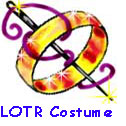










|
|
Of Masks, Men and Vast Designs: Weta gets
to work
From New Line Cinema press release,
December 2001
"The contribution of Richard Taylor & Tania Rodger and their WETA Workshop
has been essential in putting this film together. They truly understood my
desire to make every inch of this production feel real. Right down to the
pitted, greasy, dirty armor, WETA has gone the extra distance to get the
details right."
- Peter Jackson
Peter Jackson made another stunningly ambitious decision early on in the
development of The Lord of the Rings: The production would make every single
item in Middle-earth from scratch. It made logical sense, since nothing from
Middle-earth actually exists. But Jackson's visions beget a logistical
undertaking beyond what anyone had ever attempted before.
To get an idea of the sheer scope of creating Middle-earth, consider the
following numbers:
-
more than 900 suits of hand-made armor
-
more than 2,000 rubber and safety weapons
-
more than 100 special, hand-made weapons
-
more than 20,000 individual household and everyday items handmade by
artisans
-
more than 1,600 pairs of prosthetic feet and ears, individually sized and
shaped
WETA's team oversaw it all in an effort not unlike mobilizing an army.
Richard Taylor, head of WETA, became the general spurring his troops on to
greater and greater creative achievement.
"I would say that we have been fanatical about this project," says Taylor.
"We wanted to stay fanatically loyal to the written word of Tolkien. The
people I hired are people who have an intense love of Tolkien, who bring a
totally fresh, written word approach to design. The whole design for every
little element of the entire trilogy has been figured out to the nth degree.
The bottom line was this: Everything had to feel real."
In addition to the usual motion picture crew, WETA brought on board
blacksmiths, leather-workers, sculptors and experts in medieval armor. A
special foam latexing oven was running 24 hours a day, 7 days a week to
churn out Hobbit ears and feet, Uruk-Hai arms and legs, among other
prosthetics.
"The level of reality in WETA's creations was such that you could pick up a
sword that looked completely real and find out it was made of rubber. Their
stuff looks that good," says Peter Jackson.
In addition to weapons and props, WETA brought to life some of
Middle-earth's most imaginative creatures, including the Orcs, of whom no
two are alike. WETA artisans created gray, wrinkled prosthetic skin suits -
resembling elephant hide - and black armor resembling an insect's
exoskeleton to produce the Orcs' frightening, insect-meets-medieval-knight
appearance.
Each of the 200 Orc heads made for the film was unique - an individually
shaped mask made of latex foam silicone and implanted with yak hair, woven
strand by strand for different hair styles. WETA also forged blue-tinged
prosthetic feet, with long, curving claws, to stick out from the Orcs'
knee-high boots. The look was completed with layers of Middle-earth mud.
"I wanted the Orcs to look like Roman soldiers," says Richard Taylor, "who
live under an ethic of fear of their leaders."
The physical effects team of Steve Ingram, Richard Cordobes and Blair Foord
also joined in the fun to manipulate the natural environment, creating rain,
snow, fire and wind storms with spray pipes and giant fans, as well as an
enormous volume of mist, steam, fog and smoke through the use of special
liquids. The team also created fake rivers and streams running through fake
forests on soundstages.
Throughout, the WETA team had one "bible" they used as a constant source of
reference: Tolkien's original novels. "We would photocopy appropriate
passages from the books and place them all around the workshops as the
artists worked," explains Richard Taylor. "We were never without Tolkien's
spirit on the set."
The scale of every character from 3'6"-inch Hobbits to the huge Cave Troll,
had to also be taken into consideration by WETA and the costume department.
As Richard Taylor of WETA notes: "We had to create almost everything at
least twice in different scales. The mathematics alone was a staggering
challenge. But it was the only way to stay true to what Tolkien created in
his imagination: a world of many different sizes."
LOTR Home | The Hobbit | News 'n' Exhibits | Characters | Quick Costumes | Making 'Em | Buy It | Resources | Community | Search Us | Contact Us
Up | From Hobbits to Elves | Of Masks, Men and Vast Designs | Many Cultures of the Ring | Research Links | Researching Sources | Book Reviews
This page was last updated
04/22/08
|



